Malocclusion, what it is and how to correct the malocclusion of the teeth of the lower and upper jaw.
In this article, our orthodontists will tell you:
- What is a human malocclusion?
- Symptoms (signs) of malocclusion.
- Types of malocclusion.
- Causes and consequences of malocclusion.
- How to treat (correct) malocclusion in adults.
- You will also get an answer to the question "How much does it cost to correct a malocclusion in our dentistry?"
There are significantly fewer people with a correct bite than with an incorrect one. The degree of pathology is often insignificant, however, it is advisable to exclude defects and prevent problems that can cause even minor deviations.
Malocclusion of teeth in humans is a violation of the closure and position of the teeth in relation to each other. Below in the photo you will see an example of the correct closure of the teeth and one of the many types of malocclusion.
Signs of malocclusion.
Only an orthodontist can accurately determine the correctness of your bite. It is important to know that some symptoms of malocclusion are visible to the naked eye. A sign may be a twisted teeth of the lower or upper jaw, a lower jaw pushed forward or a protruding upper lip, possible facial asymmetry and improper closure of the dentition with each other.
If you have one of these signs, please call: (0352) 40 00 08; (098) 130 13 71 and make an appointment for a consultation and initial examination by an orthodontist.
Types of malocclusion.
We can talk about a physiologically correct bite if the teeth fit snugly together, the upper and lower teeth correlate with each other, and the imaginary longitudinal axis that divides the face into symmetrical parts passes between the incisors. It is allowed if the upper teeth slightly cover the lower ones - no more than a third.
Imperfections are expressed in different ways:
- With an open bite, there is no contact between the jaws - completely or partially.
- With a deep bite, the lower teeth are significantly covered by the upper teeth.
- A forward jaw indicates a mesial bite.
- A well-developed upper jaw is called a distal overbite.
- It happens that the teeth intersect each other like scissors, so this bite is called a cross bite.
- A lowering appearance occurs against the background of tooth decay and loss.
- The dystopic type is characterized by the formation of some teeth outside the correct location.
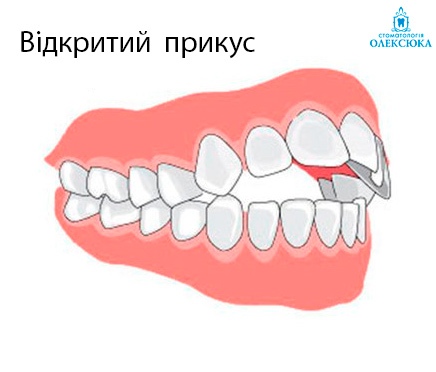
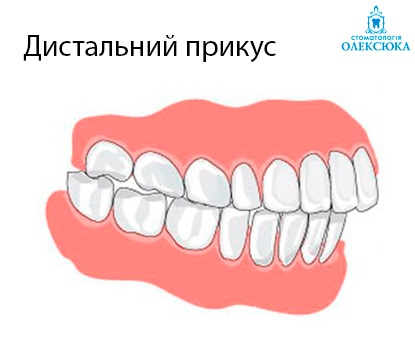
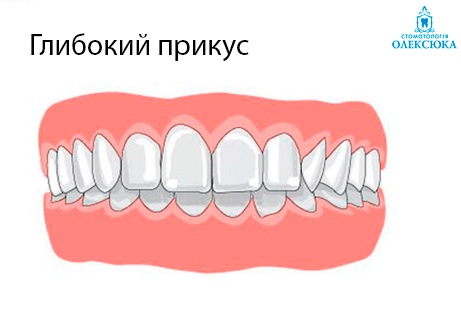
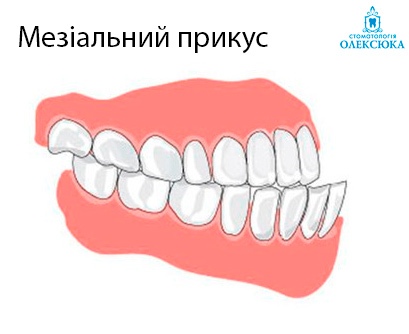
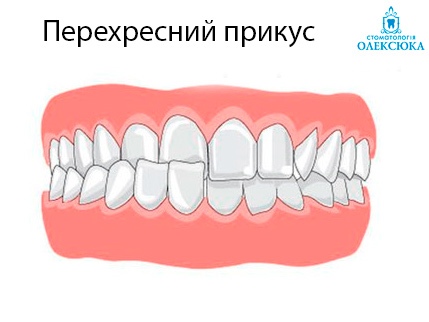
There is also an abnormal type of bite.
Below, we invite you to watch a short video that clearly demonstrates the classification of malocclusion. It is better to see once than to be confused in medical terms.
Causes of malocclusion.
Many factors influence the formation of a person's bite. We all come from childhood, so it all starts there:
- heredity and trauma during childbirth.
- No possibility of breastfeeding.
- Excessive sucking of the pacifier.
- Early or late loss of temporary teeth.
- Oral breathing against the background of chronic runny nose (adenoids).
- Advanced caries.
- Metabolic disorders.
Consequences of malocclusion.
In addition to aesthetic considerations in order to harmonize the appearance, it is recommended to correct malocclusion to prevent a number of possible physiological disorders. An incorrect bite directly threatens to damage the teeth, leading to periodontal disease, early enamel wear, and caries.
There may be maxillofacial problems: facial misalignment, clicking when chewing and opening the mouth. Constant insufficient chewing of food, mainly on one side of the mouth, causes gastrointestinal problems. If the wrong breathing mechanism is developed, ENT diseases develop. Speech defects and diction disorders are possible.
Correction of malocclusion in adults.
According to statistics, nine out of ten people have problems with their bite, and every third such case requires the use of a special technique. According to modern orthodontics, malocclusion is not a death sentence, and crooked teeth can be straightened at any time. However, an attractive, perfect smile is an essential component of a successful person, and without a correct bite, it is simply impossible.
Many people wonder whether it makes sense to address issues related to bite correction at all. For many, this flaw may seem insignificant, but in fact, it is associated with a number of psychological problems that can negatively affect a person's life. Existing problems with the bite can cause gum disease, provoke the appearance of caries, contribute to tooth abrasion, and make it difficult to fit dentures.
Adults with an incorrect bite are more likely to suffer from migraines, digestive problems, and other health problems. Malocclusion can cause problems with the functioning of the jaws.
At what age can the bite be corrected?
It is best to correct malocclusion in adolescence. At this time, the teenager is actively growing, the bite of the teeth is completing its formation, and intervention in this case will give the best result. However, adult bite correction has certain specifics - in particular, in this case, you may encounter a number of difficulties during the correction:
1) The key problem is that after the jawbones are formed, a lot of effort is required to transform them. In particular, after the age of thirty, the blood supply to the tissues slows down and it is more difficult to correct the movement of the teeth;
2) as a rule, an adult patient's teeth do not look the best - they are more fragile, they have many fillings, and therefore it is difficult to use orthodontic structures for them;
3) if there are distant teeth in the jaw, this can cause bone atrophy and, as a result, slow down the speed of bite correction;
4) bite correction in adults is more expensive. At the same time, taking into account the above, the correction of malocclusion is an important and necessary thing, and it is also relevant even for adults, not just children.
Correction of malocclusion.
Orthodontic treatment is quite complex, multi-stage and expensive. It is important to monitor the development of the child's bite from an early age - to observe how the teeth erupt and grow, to visually correlate the development of the jaws. At the age of one and a half years, the child should begin to develop the skills of caring for the teeth and oral cavity. The child's diet should be varied and contain solid food.
It should be understood that interdental gaps under the age of eight are not a pathology - after the teeth change to molars, the gaps disappear. Adverse bite changes are easier to correct in childhood, so preventive visits to the dentist should be regular. Therapy of bite pathologies usually takes a long time, the choice of method depends on the complexity of the specific situation and the age at which treatment is started.
As a rule, the only limitation is caries and its advanced forms. A panoramic X-ray of the skull and casts of the jaws help the orthodontist determine the treatment plan. Removable and fixed devices help to eliminate bite defects. Orthodontic interventions are considered to be painless in sensations, some inconvenience may be caused by the placement and wearing of devices at the initial stage. Removable devices include brackets and plates that are used in the treatment of children and adolescents.
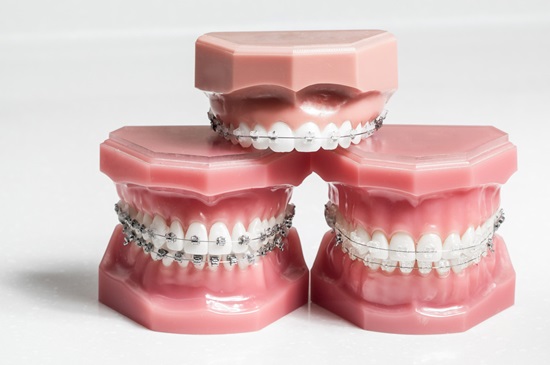
Fixed braces are used to correct the bite in adults. Braces are a structure of small locks connected by an arch. Each lock is attached to the surface of the teeth with a special glue, and the arch helps to neutralize the impact on the teeth. Braces are made of different materials: metal, plastic, sapphire. There are lingual braces that are almost invisible from the outside - such devices are attached to the inner surface of the teeth. The choice of braces type is determined by the patient's budget.
For effective treatment, it is sometimes necessary to remove several teeth, and surgical correction of the bite may also be required. At the final stage of treatment, plastic aligners and fixed retainers made of metal wire are used to stabilize the achieved result. Modern technologies allow the orthodontist to normalize the bite not only before the end of the formation of the body, as was commonly believed until recently, but also in adulthood, almost regardless of the degree of complexity of the case.
Prices for teeth straightening.
You should understand that corrective maxillofacial surgery is considered a medical procedure, not a cosmetic one, and straightening your teeth will cost you less than correcting the consequences of more expensive dental problems in the future.
- You come to see our orthodontist. After the examination, the dentist diagnoses your type and severity of the bite defect. This stage plays a decisive role in calculating the cost of teeth alignment. The orthodontist will also tell you in detail about the upcoming treatment and its duration.
- The cost estimate is determined only after a detailed individual consultation between the orthodontist and the patient.
- Interested patients can study the prices for bite correction in our dentistry in the "prices" section. Taking into account our experience, the average cost of bite correction with braces will be from 1000 euros.
Teeth straightening with braces
Teeth straightening with braces can be used when it comes to treating adult patients, i.e. people who already have an incorrectly formed bite. Patients who have had a long period of bite correction often have no idea how braces are installed. Ignorance breeds distrust and even fear. In fact, this is a painstaking and multi-stage process, but it is simple and completely painless.
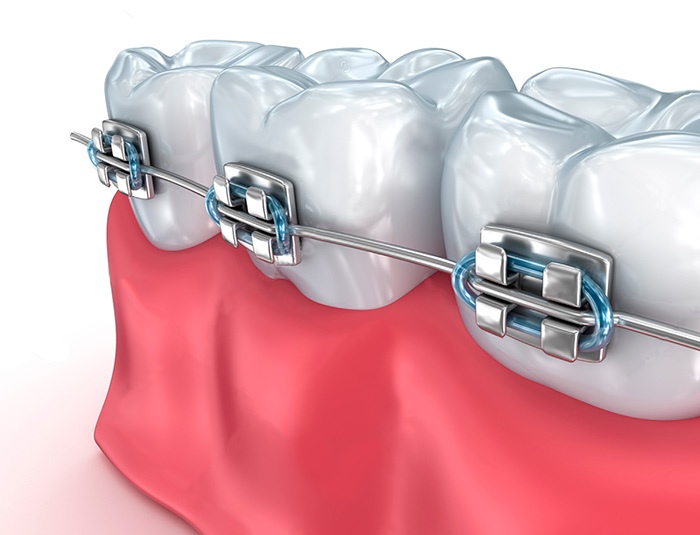
How a modern bracket system works. This fixed orthodontic structure consists of:
- small single bracket plates, or braces themselves;
- The arc that connects them;
- fixing ligatures in the form of elastic bands or pull tabs
All these elements become a single system only on the patient's teeth. They are assembled into a single whole by an orthodontist.
The process of placing braces
The braces are placed by brushing your teeth with a special toothpaste. Beforehand, the doctor uses a mouth dilator to provide a "wide field" for work and access to the back teeth. Then he covers the enamel with a special chemical composition and rinses it with water after a while. The bracket fixation areas are treated with a protective gel.
Light-curing material is applied to the back of the bracket and pressed against the tooth. The remaining material is removed. After positioning the bracket, the doctor shines a photopolymer lamp, under the influence of which the material quickly hardens and firmly bonds to the enamel surface. Thus, braces are placed on all teeth in sequence.
After that, an arch is inserted into the grooves, which is designed to align the teeth. It "remembers" the shape originally given to it and tries to return it, even when it is strongly bent. This is the mechanism of the bracket system.
Periodically, it is necessary to visit the dentist to replace the arch with a more elastic one or to tighten the ligatures. On average, the installation of a bracket system takes 1-1.5 hours. Ligature-free braces with locks are installed faster. For lingual systems that are fixed on the inside of the dentition, more time is required. After the process is completed, the patient returns home. But it will be possible to eat only after 2 hours. In the first days, you may experience minor toothache and discomfort. This phenomenon is considered normal and does not last long. If the pain is more difficult to tolerate, you can relieve it with painkillers - Paracetamol, Nurofen, Rapidor or others prescribed by your doctor.
Does the placement of braces on the upper and lower jaws differ?
The placement process is no different. Most often, patients are interested in the question of whether it is possible to put braces on one jaw? It is possible to install orthodontic constructions only on the upper or lower jaw, but only in cases where:
- you have a properly formed bite;
- if only 1 or 2 teeth are twisted.
In all other cases, we do not recommend braces for only one jaw. Let's predict a situation where your upper jaw teeth are crooked, and the lower ones are only slightly and imperceptibly. Immediately, the patient has a "verdict" - there is nothing wrong with the lower teeth, so we will treat only the upper ones. We remember that the correct bite is the correct closure of the teeth. After treatment with braces in the upper jaw, you noticed that your teeth began to close poorly. You can immediately tell that the treatment has gone to waste. Therefore, it is necessary to align both the upper and lower jaws at the same time. However, the decision can only be made by an orthodontist after a detailed examination of the patient.
Troubleshooting problems with braces on your own.
If you have minor problems during braces treatment, do not rush to make an appointment. You can solve some of them on your own:
- A scratch has formed on the inner surface of the cheek or lip due to contact with the braces. Seal the bracket with a bead of orthodontic wax.
- The arc has fallen out of the last lock. Take the tweezers, go to the mirror, and put it back in.
- The arc is out of the lock. Insulate it with a cotton swab or wax ball.
- The wire ligature has become loose during brushing. Use a pencil eraser to return the retainer to its original shape.
The process of bite correction begins immediately after the doctor fits you with braces. It lasts for a year and a half or more. The duration of treatment depends on the type and method of placing the orthodontic system, the material of manufacture, and the complexity of the defect. But there is always a result, so remember that after removing the braces, you will experience pleasant emotions!
Types of braces - systems and types of braces.
There are two principles of braces installation: outside the dentition (vestibular braces), and inside - lingual braces.
Lingual bra ces are attached to the teeth from the inside, so they are not visible to others. Compared to vestibular braces, they are more effective because they can correct the problem of a "deep" bite, but the cost of internal braces is much higher than that of external braces. Lingual braces are more difficult to get used to because they reduce the size of the oral cavity. Patients often have problems with diction after placement, but after a few weeks, the tongue gets used to the braces, and diction is restored. Such braces are more difficult to care for because they are out of the patient's sight when cleaning.
External braces are the most common in orthodontic practice due to the lower cost of construction. They are made of metal, plastic or polymers. There are also two principles of attaching the arch to the braces: with elastic ligatures or ligature-free structures. The advantage of metal braces is the low friction force between the braces and the arch, due to the same material of construction. For patients with metal allergies, braces can be made of precious metals (gold), but this significantly affects the cost of treatment. For patients who are not satisfied with the aesthetic appearance of metal on their teeth, there are plastic braces. In this design, the braces themselves are made of plastic, but a metal arch is used. Such braces are not much more expensive than metal braces, but they have a number of disadvantages: plastic braces are fragile and change color over time due to the influence of food dyes.
Ceramic bra ces are the most expensive among external braces. Their main advantage is that their color matches the color of the teeth, which makes them look the most aesthetically pleasing. The friction between the braces and the arch in such structures is higher than in metal ones, which can affect the duration of wear.
Sapphire braces are made of artificial sapphire crystals, they are absolutely transparent, invisible and not subject to staining.
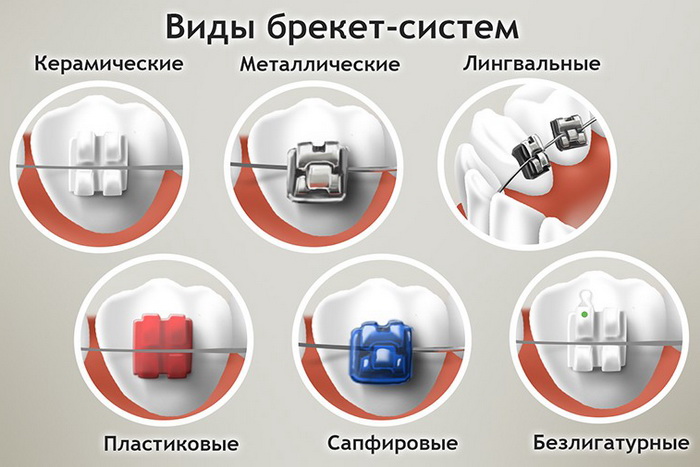
Braces: pros and cons.
Not everyone wants to wear "braces on their teeth". This is how braces used to be called. Most people associate them with discomfort and aesthetic unattractiveness. But this is currently a false statement. We have collected for you the main pros and cons of bite correction with the help of orthodontic structures.
![]() With modern braces, it is possible to look beautiful because there is an unlimited number of materials close to natural teeth. There are invisible lingual braces that are attached to the inside of the tooth. And for children, even the most ordinary metal braces can be decorated with colorful rubber bands, which looks quite stylish.
With modern braces, it is possible to look beautiful because there is an unlimited number of materials close to natural teeth. There are invisible lingual braces that are attached to the inside of the tooth. And for children, even the most ordinary metal braces can be decorated with colorful rubber bands, which looks quite stylish.
![]() You can correct any problem with the bite or other aesthetic pathologies at any stage. Almost from the first days after braces are placed, you can notice improvements in the positive dynamics of your appearance. You will achieve a beautiful, healthy smile without surgery.
You can correct any problem with the bite or other aesthetic pathologies at any stage. Almost from the first days after braces are placed, you can notice improvements in the positive dynamics of your appearance. You will achieve a beautiful, healthy smile without surgery.
![]() There are no age restrictions. Orthodontic appliances can be installed at any age if you have teeth. The limitation here may be passive personal interest.
There are no age restrictions. Orthodontic appliances can be installed at any age if you have teeth. The limitation here may be passive personal interest.
![]() There are no allergies to braces, they do not spoil the enamel and it does not hurt.
There are no allergies to braces, they do not spoil the enamel and it does not hurt.
![]() In order to maximize the benefits of wearing braces, you need to seriously reconsider your attitude to oral hygiene.
In order to maximize the benefits of wearing braces, you need to seriously reconsider your attitude to oral hygiene.
![]() The duration of wearing orthodontic systems often lasts from one to three years. But this period seems significant only during the first three months. After you see significant changes in your smile, this process becomes inspiring. And each time you will realize how right you were and how right you were to get braces.
The duration of wearing orthodontic systems often lasts from one to three years. But this period seems significant only during the first three months. After you see significant changes in your smile, this process becomes inspiring. And each time you will realize how right you were and how right you were to get braces.
![]() High prices for braces. All dental structures are expensive. But in the end, your treatment will pay off, because bite correction will help you prevent the further development of other diseases of the oral cavity and the body as a whole.
High prices for braces. All dental structures are expensive. But in the end, your treatment will pay off, because bite correction will help you prevent the further development of other diseases of the oral cavity and the body as a whole.
Braces before and after.
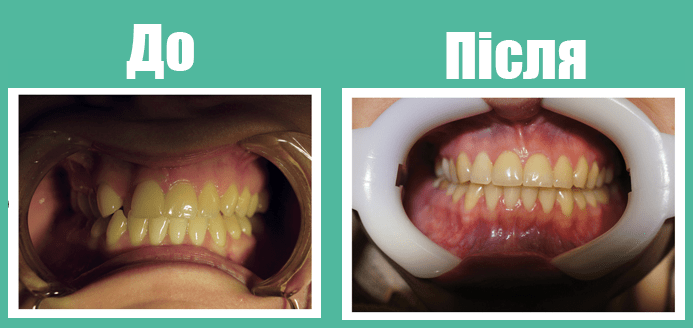
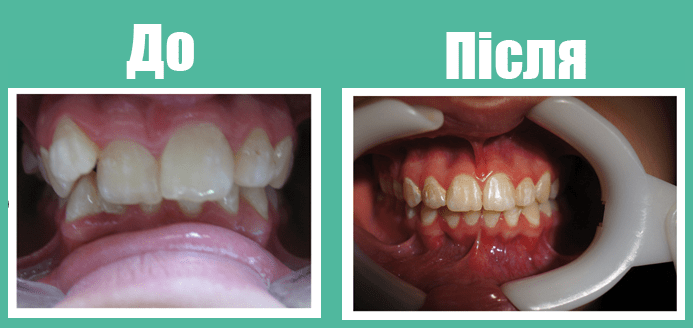
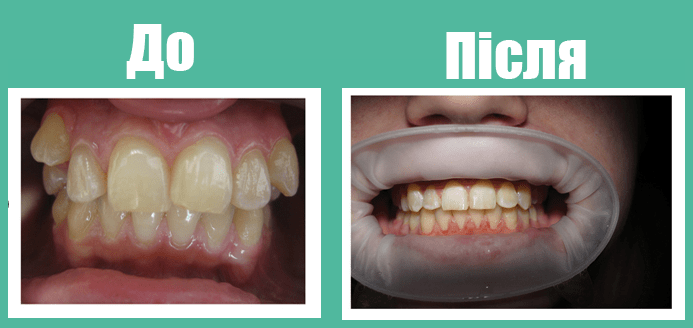
The cost of putting braces in "Oleksiuk Dentistry" in Ternopil. Ternopil.
The cost of braces varies depending on a number of factors. It all depends on the degree of correction required for your teeth, the metal you choose, and the type of braces you use. You can find the main prices in the "prices" section. We understand that the price is not small, so our clinic has the opportunity to divide the cost of your treatment into several payments. Everything is discussed with your orthodontist.
Metal braces - types, fitting process, care and prices.
Metal braces are orthodontic systems for dental correction that are popular and widely used. Metal braces are used to correct the dentition in both adults and children. The design is made of medical stainless steel with the use of nickel-titanium alloys. The design of metal braces is quite complex, although at first glance it seems very simple. The orthodontic arch is made of flexible and elastic steel. It is this arch that moves the teeth in the right direction.
Types of metal braces.
Like other types of braces, iron braces are divided into vestibular (external) and lingual (those installed on the inside of the teeth).
Lingual bra ces are made of metal or alloys of different metals. It is simply pointless to make them aesthetic, because they are located inside the jaw and are invisible to others. Classic vestibular metal braces are divided into:
- self-ligating metal braces (ligature-free ) - the arch is fixed with a lock;
- ligature metal braces - here, elastic bands and ligatures are used to hold the arch in the bracket groove.
How metal braces are placed in our dentistry.
Before placing metal braces, we must perform a number of preventive procedures.
- Cleansing teeth from tartar and plaque, strengthening enamel using various techniques so that teeth are not damaged during the process of wearing braces for many months.
- After that, our hygienist will give you a thorough instruction on how to care for your teeth with braces.
- Our hygienist will tell you about the range of hygiene products that should be used so that your teeth do not suffer while wearing orthodontic systems.
- Next, the orthodontist carefully positions the braces. The quality of bite correction will depend on this.
Braces in the metal system are attached to the previously prepared tooth surface with a special glue. Then they are covered with a special fluoride paste.
Advantages and disadvantages of iron braces.
The advantage of metal systems is 100% achievement of the desired effect. Other advantages include low cost compared to other types of braces and durability. The slight friction that occurs during treatment between the dentition and the bracket structure also contributes to faster achievement of good results.
The disadvantage of metal orthodontic systems is their visibility on the patient's teeth. But, if you have the means, this disadvantage can be compensated for by making brackets from modern non-ferrous alloys that give an aesthetic appearance. After that, the brackets will turn into a beautiful and fashionable accessory.
Caring for metal braces.
When treated with such a system, it is difficult to maintain oral hygiene. To solve such problems, it is necessary to purchase special brushes and devices designed for brushing teeth during braces treatment. Today they are sold in any pharmacy.
During the treatment period, the patient should change their diet and follow the recommendations of the orthodontist. During treatment, special attention should be paid to hygiene, because one of the main disadvantages of metal systems is the provocation of caries due to plaque accumulation.
The cost of placing metal braces in Ternopil.
Prices for metal braces depend on the type of braces you choose, as well as the length of time you wear them. Iron braces are the oldest and most common type of orthodontic treatment.
This is an inexpensive treatment and quick teeth straightening. Lingual braces are more expensive because they are difficult to install and adjust. You can find detailed prices in the "Prices" section of our website or call (0352) 40 00 08 or (098) 130 13 71.
Ceramic braces - your smile is your prestige
Vestibular ceramic braces are one of the most common malocclusion corrections.
Despite their external location, these structures are not too noticeable to others, so they do not spoil the aesthetics of a smile.
Materials for the manufacture of ceramic braces.
The main elements of such orthodontic systems are made of high-quality dental ceramics. This is a matte material that is close in appearance to natural tooth enamel. The shade of braces is selected depending on the color of the patient's teeth.
The arc that connects the ceramic plates is made of a special metal. This part of the structure is most noticeable, but it does not spoil the smile, especially if it is covered with a white composite material.
Unlike sapphire elements, ceramics do not sparkle in the light, almost merging with the teeth. For some patients, this becomes one of the driving factors influencing the choice of braces.
Features of placing braces made of ceramics.
The process of placing ceramic braces has no distinctive features. It takes an average of 1.5 hours and consists of several main stages. The enamel of the teeth is treated for better adhesion to the braces, then composite glue is applied, the plates are positioned on the teeth in stages and pressed firmly for fixation. At the final stage, a metal arch is inserted into the grooves and fixed with special ligatures. The process of fixing self-ligating systems, which are attached with special locks, is faster and easier. They are more expensive, but more effective and convenient for the patient, as they do not require frequent visits to the dentist.
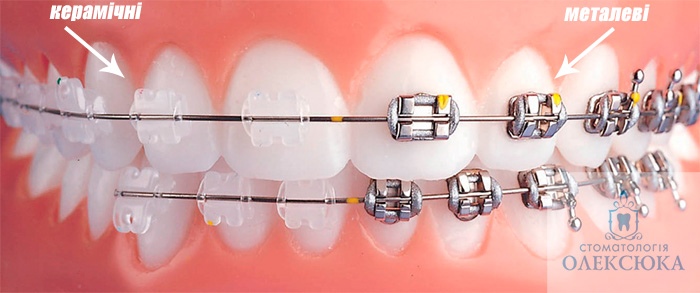
Advantages of ceramic braces.
The advantages of ceramic braces are that they:
- They look aesthetically pleasing and do not prevent a teenager or an adult from feeling attractive.
- They are securely fixed on the enamel surface and hold well on the teeth over time.
- They quickly become familiar to the patient, as the discomfort of the first weeks quickly disappears.
- They do not injure the mucous membrane, as is the case with metal systems.
- They allow you to take normal photos because they do not reflect light like sapphire and metal.
- They are rejected by the body in a small number of cases.
- They are cheaper than sapphire braces.
Disadvantages of using ceramics in orthodontic structures.
Like other bite correction systems, ceramic braces have certain disadvantages. The main disadvantages:
- Cost. Ceramics are more expensive than metal and plastic.
- Tight fit to the tooth surface. This can aggravate existing enamel damage.
- Medium strength. Braces made of dental ceramics require care when caring for and eating.
- Duration of treatment. These systems will have to be worn on the teeth longer than metal ones, since the force of their impact on the teeth is less. Ceramics retains its original color well throughout the entire treatment period. But lovers of coffee, freshly squeezed juices and berries should keep in mind that plaque that accumulates on braces quickly stains, so they become darker.
Therefore, increased attention should be paid to the cleaning of ceramic bite correction systems.
Which ceramic braces are better.
The patient chooses the type of braces together with the orthodontist. Each situation has its own recommendations and limitations. For example, intense sports activities may be a contraindication to the placement of more fragile ceramic braces.
An orthodontist will help you determine which option is best for you. When making a choice, specialists are guided by the patient's dental system, age, characteristics, and occupation.
Ceramic braces - price in Oleksiuk's Dentistry in Ternopil.
Ceramic braces are a great option for teens who are concerned about the appearance of metal braces. As we have already explained, ceramic systems are similar to metal systems, except that they are made of a tooth-colored material that helps to blend in with the teeth for an "invisible" appearance. Although ceramic brackets are less visible, they are more expensive than other types of braces. To learn more about ceramic braces, how much they cost, and whether they are right for you, contact our dentistry for an orthodontic consultation. Dentistry "Oleksiuk" is the best dentistry in Ternopil and Ternopil region for adults and children.
Contact us by phone (0352) 40 00 08 (098) 130 13 71 to come for a consultation today!
Lingual (internal) braces Incognito (Incognito) - invisible bite correction.
Attention! Dentistry "Oleksiuk" is a certified dental center in Ukraine for working with the lingual system "Incognito".You can get advice on braces by calling (0352) 40 00 08 or (098) 130 13 71.
Advantages of lingual braces.
According to statistics, about 90% of people alive today had uneven teeth in childhood, for which there are many reasons: from genetics to the habit of sucking their thumb in childhood. It is possible to straighten the dentition in adolescence with braces, but many young people refuse them because braces are supposedly very visible on the teeth.
Gradually, a noticeable facial deformity develops, which, along with crooked teeth, does not add to self-confidence in adulthood. As a result, it will take longer and more expensive to correct defects in adulthood. In order to avoid all these problems, it is worth installing lingual braces, which remain completely invisible to other people, as they are located on the inside of the crowns of the teeth.
Treatment with lingual braces is characterized by a lot of advantages.
It is also important that wearing lingual internal braces practically eliminates the likelihood that the patient will need to stop treatment early due to the appearance of complexes or the approach of such an important event as a wedding, where all newlyweds want to look perfect.
When are lingual braces indicated...
![]() Invisible braces are used to correct dentition closure disorders or tooth position. Sometimes their placement provides a much better effect than the placement of vestibular braces.
Invisible braces are used to correct dentition closure disorders or tooth position. Sometimes their placement provides a much better effect than the placement of vestibular braces.
![]() Sometimes a greater therapeutic effect can be achieved by combining them with external orthodontic systems. For example, lingual braces are often placed on the upper jaw, and vestibular braces are placed on the lower jaw. This combination can be used in the presence of certain features of the jaw structure, as well as in case of difficulties with adaptation to lingual systems or for reasons of economy.
Sometimes a greater therapeutic effect can be achieved by combining them with external orthodontic systems. For example, lingual braces are often placed on the upper jaw, and vestibular braces are placed on the lower jaw. This combination can be used in the presence of certain features of the jaw structure, as well as in case of difficulties with adaptation to lingual systems or for reasons of economy.
![]() Before putting on lingual braces, it is necessary to cure caries and eliminate acute inflammatory processes in the oral cavity. An experienced doctor will be able to tell you how long to wear lingual braces after the diagnosis, but it should be borne in mind that new problems may appear during treatment, which may slightly delay the wearing of the bracket system.
Before putting on lingual braces, it is necessary to cure caries and eliminate acute inflammatory processes in the oral cavity. An experienced doctor will be able to tell you how long to wear lingual braces after the diagnosis, but it should be borne in mind that new problems may appear during treatment, which may slightly delay the wearing of the bracket system.
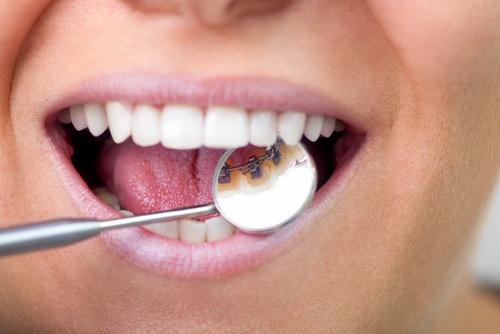
Lingual braces are made on an individual basis. First, impressions are taken and dental photographs are taken. Then an individual orthodontic design is developed, after which the braces are fixed to the inside of the crowns of the teeth, and a long treatment process begins.
How long should I wear invisible braces?
On average, invisible braces have to be worn for 1-1.5 years. As with any other orthodontic structures, lingual braces take some getting used to. It will take 2-4 weeks. Thanks to the individual design, the discomfort that occurs when wearing lingual braces is minimized.
How to care for lingual orthodontic systems?
The presence of lingual braces on the teeth requires particularly careful oral care. Therefore, the orthodontist teaches the patient how to use the braces after fitting them:
- irrigator;
- with dental floss;
- brushes;
- with a toothbrush.
Invisible braces can be used from the age of 13. They are used by teachers, actors, announcers, and other people who, due to their profession, need to be visible all the time.
Read more about Incognito braces.
Incognito lingual braces (made in Germany) are made of an alloy based on gold. Such systems are ideal for people who are allergic to nickel. It will take approximately 1.5-2 months to manufacture the Incognito lingual orthodontic system. Incognito lingual braces have the following advantages.
- absence of diction disorders that sometimes occur immediately after the placement of visible braces;
- the ability to eliminate tooth twisting with a vertical groove without the use of other devices;
- Their self-cleaning ability is higher than that of external orthodontic systems;
- Incognito braces are manufactured only in Germany, so you don't have to worry about quality.
In order to make an Incognito brace, an orthodontist refers a person for a detailed tomography and X-ray, then makes an impression of the teeth. Using a special program, a model of the jaw is created and the parameters of the future brackets are carefully selected.
The main advantage of lingual braces is that you can enjoy the result long before the end of treatment. The first changes will appear after 2-3 months of wearing the system, so your appearance and smile will be transformed gradually, without raising questions from the people around you.
Video about how braces are made
The cost of lingual braces Incognito (Incognito) in Ternopil.
If you want to install lingual braces, you need to keep in mind that lingual braces cannot be cheap. Some clinics offer their clients lingual braces on credit, in which case a person pays their cost in equal installments every month or at each visit to the orthodontist, which are regularly required to correct the braces. The price of invisible braces may vary depending on the degree of complexity, pathology, and many other factors. You shouldn't save much on braces. It is pointless to look for a place where lingual braces are installed inexpensively. Their quality determines how quickly and effectively the treatment will go, as well as whether side effects (caries) will appear. If the cost of lingual braces is too high, you can always choose less expensive vestibular orthodontic systems.
Aligners for teeth straightening (aligners)
Dental aligners are removable orthopedic devices made in the form of two interconnected plates of transparent polymeric materials. The main purpose of this dental instrument is to correct minor malocclusion. Mouth guards are made individually for each patient, for this purpose, a picture of his or her jaw is taken.
The material used is usually silicone or plastic, so mouthguards can be worn by people with an allergy to nitinol (the metal used to make the braces' arch). The aligner must be worn for the whole day (about 22 hours), it acts with a slight force on the dentition, gradually aligning it. This method of treatment is suitable for people who have minor defects in the dentition.
What types of mouthguards are used?
Depending on the quality and complexity of the design, they are of the following types:
- Standard dental aligners - are mass-produced at the factory and are used to align teeth by selecting the size. It is very difficult to find a more or less accurate mouthguard, so most often the design does not fit well on the dentition and can rub the gums.
- Thermoplastic mouth guards are also factory-made, but the material from which they are made has one interesting property: when heated, it becomes soft and easily takes the required shape when cooled. Such models are put on the dentition after being placed in hot water. As a result, the structure is tightly fixed, repeating all the features of the patient's teeth.
- A custom-made aligner is a more expensive design option. It requires a lot of time to manufacture, as it requires taking measurements and making an accurate 3D model. However, such a product will exactly repeat the shape of the patient's dentition, and therefore will be more comfortable to wear. In addition, the most complex malocclusion can be corrected in this way.
The method of therapy with the help of aligners (bite treatment with aligners).
Before starting correction with this method, the orthopedic surgeon conducts an examination and identifies the disorders that need to be corrected. Next, a treatment plan is drawn up and the type of aligners that a particular patient needs is selected. Measurements are taken and impressions are made of the dentition of the upper and lower jaw. Using the impression, a plaster model is made in a special laboratory, which is stored throughout the treatment process. It is used both for the manufacture of the first mouthguard and all subsequent ones after the necessary corrections have been made.
The finished structure is fitted to the patient. Then, periodically, the patient must visit the doctor to monitor the treatment and replace the mouthguard (if necessary). The time for correcting tooth growth using this method depends on the complexity of the defect and can take from several months to two years.
Specifics of mouthguard care.
While wearing aligners, it is not recommended to eat foods that contain aggressive dyes, otherwise they should be removed during meals. After each meal, the aligner must be washed. To do this, use only purified water. The outside is cleaned with a regular toothbrush and toothpaste.
By following these simple rules, the patient will be able to maintain the beautiful appearance of the orthopedic structure throughout the entire period of its use!